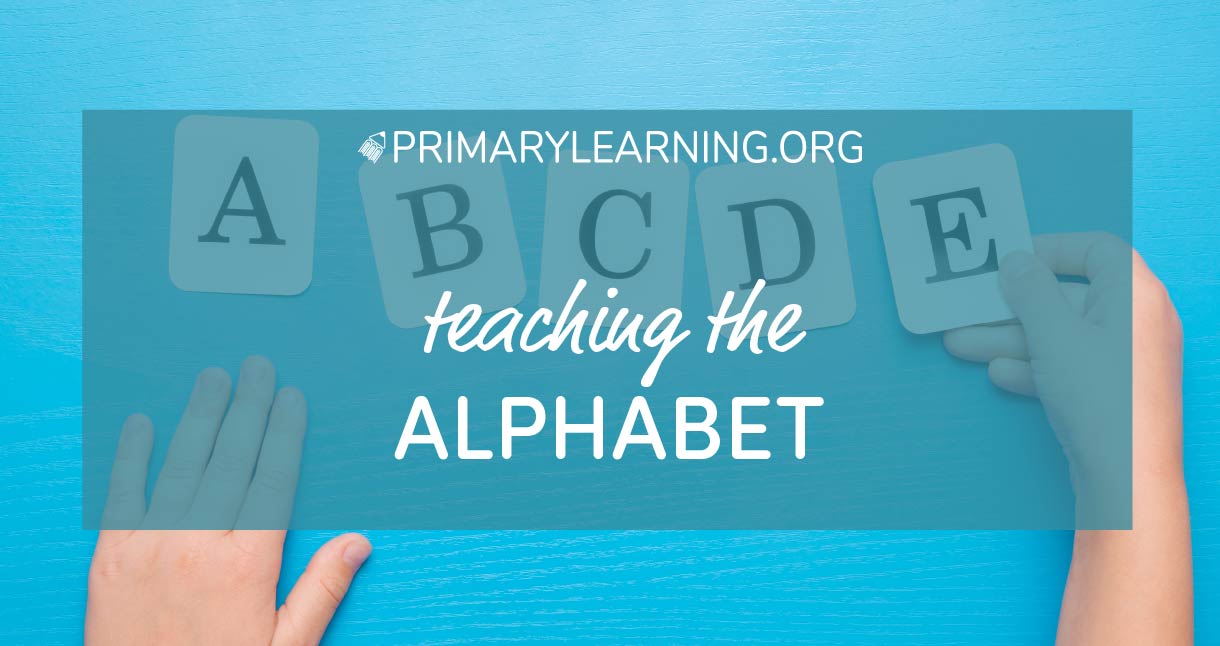

Posted by: Alesia Netuk
Updated: October 2nd, 2023
Teaching The Alphabet
Teaching The Alphabet
For many preschool and kindergarten children, their first experience with the alphabet is learning to sing the alphabet song. While this familiarizes children with the names of the letters, there are many other concepts to learn in order for them to work successfully with letters. Children need to learn to recognize the letters in print, how to form them, and the sounds they make.
Letter Recognition
There are many activities educators can use to teach children how to recognize letters when they see them in print. Embedding letter recognition activities regularly into instruction will support children in their learning. Start with a few letters and gradually add more as children master them. It may be motivating to begin with letters of personal significance, such as those in a child’s name. For example, provide name cards for children to reference and have them practice naming the letters. Having their names displayed in multiple areas, such as above coat hooks, on a birthday list, and on art work, will provide them with frequent exposure to the letters that comprise their names.
You may wish to use a few quick activities to practice letter recognition. Try printing the letters a child is learning on a piece of paper, multiple times. Ask the child to find a certain letter. Using a bingo dabber or a stamper, he marks off all the letters. Instead of asking children to find letters yourself, you can also create simple spinners, using a blackline master and a paperclip. Fill in the letters you are focusing on, then have children take turns using the spinner.
Letter A hands-on activities to practice letter recognition skills:
Letter A Wheel Spinner
Practice letter A or beginning sound A with cute pictures kids will reveal as they spin the wheel. This letter A spinner would be a great addition to your literacy centre.
Letter A Wheel Spinner
Letter A Crown
With this letter A crown, kids practice uppercase and lowercase letter A formation and identify four pictures that begin with the letter A sound.
Letter A Crown
Letter A Recognition Worksheet
With this activity, kids help the alien to find his letters by circling the upper and lower case letters A. Kids work on letter A recognition and discrimination skills.
Letter A Recognition Worksheet
Tracing Uppercase Letter A
Kids practice their handwriting by tracing uppercase letter A by following directions and develop proper letter A formation from the beginning. For preschool and kindergarten.
Tracing Uppercase Letter A
Educators can incorporate letter recognition activities into artwork. For example, provide children with a large letter on a piece of paper. Give them the opportunity to follow the outline, either coloring it, painting it, or adding materials like stickers, stamps, or pasta noodles. Display the children’s artwork and refer to it to help them remember the visual appearance of letters.
A kinesthetic activity for learning letters is to place letters on the floor. This can be done using painter’s tape or with alphabet mats. Call out a letter and have children move to the correct place on the floor.
Playdough alphabet mats combine learning letters and promote fine motor skills:
Learn To Write Letter A Playdough Mat
Kids make a letter A using playdough and following the arrows to learn the correct letter formation. An excellent activity for literacy centers!
Learn To Write Letter D Playdough Mat
Sneak in amazing letter mastering with this fun and engaging playdough activity. Following arrows, kindergarten students learn to write letter D.
Learn To Write Letter E Playdough Mat
The initial step in learning to write letters is acquiring the proper letter formation. Using playdough, kindergarten kids learn to write letter E.
Learn To Write Letter M Playdough Mat
Learn to write Letter M with this engaging activity. Kids will form a letter following the arrows and practice correct letter formation.
As children are learning letters, you may wish to provide them with a set of flashcards so they can practice naming the letters. Again, begin with only a few letters and as children master them, add more cards to their deck. You may wish to hole punch each card and keep them together on a binder ring. For your own tracking purposes, and to help with motivation, consider adding a small sticker, smiley face, or other symbol on a card each time a child names the letter correctly.
Printable alphabet flashcards:
Letter A Flashcards
Help children learn the alphabet with these printable letter A flashcards. Introduce the letter A, beginning sound A, and primary words starting the letter A.
Letter A Flashcards
Letter C Flashcards
Help children learn the alphabet with these printable letter C flashcards. Introduce the letter C, beginning sound C, and primary words starting the letter C.
Letter C Flashcards
Letter D Flashcards
Help children learn the alphabet with these printable letter D flashcards. Introduce the letter D, beginning sound D, and primary words starting the letter D.
Letter D Flashcards
Letter I Flashcards
Help children learn the alphabet with these printable letter I flashcards. Introduce the letter I, beginning sound I, and primary words starting the letter I.
Letter I Flashcards
A fun game to use during small group instruction is “Zoom.” Write the names of a few letters on playing cards. There should be one letter on each card. Create two or three cards for each letter. Next, add a few cards with the word “Zoom.” Deal a card to the first child. Her job is to name the letter. It’s okay to provide assistance if she needs it. Continue dealing a card to each child playing the game. If a child receives a card that says “Zoom,” he gets to take everyone’s cards. The game continues until all the cards have been dealt. The player with the most cards is the winner.
Forming Uppercase and Lowercase Letters
In addition to knowing the names of the letters and recognizing them in print, children also need instruction on the correct way to form each letter. Traditional pencil and paper tasks provide children with opportunities to trace letters made with broken lines, then practice printing them on their own. When children are engaged in writing activities and have difficulty remembering how to form a certain letter, educators can print the letter in a yellow pencil crayon or marker, and have the children trace over it in pencil.
To learn the movements that are necessary to form each letter, provide children with modalities other than pencil and paper to practice their writing. Children can use their index finger to create letters in salt trays, sand trays, hair gel in ziploc bags, in the air, on a friend’s back, or with finger paint. There are many apps that also allow children to use their fingers to practice the movements needed to form letters. Look for apps that require children to start the letters at the correct position and follow the proper pathways.
It is important for educators to model how to form letters correctly. Provide children with opportunities to see your printing. For example, create a morning message, leaving one or two words out. When children come up with suggestions for what could go in the blanks, slowly print the words, pointing out key learning such as where your marker begins and what direction it travels in as you form the letters. This is also an ideal time to start teaching children phrases that will help them remember how to form letters, such as “down, up, down, up” for ‘w.’
Letter A formation cards, posters, and tracing worksheets help develop proper letter formation from the beginning:
Tracing Uppercase Letter A
Kids practice their handwriting by tracing uppercase letter A by following directions and develop proper letter A formation from the beginning. For preschool and kindergarten.
Tracing Uppercase Letter A
Tracing Uppercase Letter K
Kids practice their handwriting by tracing uppercase letter K by following directions and develop proper letter K formation from the beginning. For preschool and kindergarten.
Tracing Uppercase Letter K
Tracing Uppercase Letter O
Kids practice their handwriting by tracing uppercase letter O by following directions and develop proper letter O formation from the beginning. For preschool and kindergarten.
Tracing Uppercase Letter O
Tracing Uppercase Letter S
Kids practice their handwriting by tracing uppercase letter S by following directions and develop proper letter S formation from the beginning. For preschool and kindergarten.
Tracing Uppercase Letter S
Letter Sounds
Children may remember letter sounds if they are associated with words that begin with the sounds. For example, pairing the letter ‘s’ with the word ‘snake’ may help children remember the ‘sss’ sound. Using a worksheet with a snake forming the letter ‘s’ with its body can help reinforce this concept. Children can color the snake or decorate it with materials. Display their sheets in the classroom or add them to a folder that children can take home to review.
Similarly, children can create artwork that helps them associate certain words with letter sounds. A lowercase ‘a’ can become an apple by coloring it red and adding a stem and leaf to the top. When modeling the sound an ‘a’ makes, exaggerate the ‘aaa’ sound as you say “apple.” Another example is an octopus, which can be created using the letter ‘o’ along with the addition of legs. Teach children to associate the ‘ah’ sound an ‘o’ makes with the word “octopus.”
Beginning sounds hands-on printables help build strong phonics skills:
Beginning Sound A Clip Cards
With these beginning sound A clip cards, children learn to identify the beginning sound A with hands-on practice strengthening fine motor skills.
Beginning Sound A Clip Cards
Letter A Mini Book
With this Letter A mini-book, preschool and kindergarten age children work on beginning sound A, improve their phonics skills, and work on early literacy skills.
Letter A Mini Book
Things With Letter A
This Letter A worksheet is an easy, no-prep way to listen for beginning sound A in words: apple, alligator, astronaut, axe, angel, apron, acorn, alien.
Things With Letter A
Things That Begin With The Letter A
This worksheet features pictures of things that begin with the letter A: angel, apple, alien, apron, alligator, acorn, astronaut, axe.
Things That Begin With The Letter A
Embed alphabet activities throughout your program to help children not only memorize the alphabet, but to understand what letters look like, how to form them, and what sounds they make. In addition to targeted letter practice, continue to provide children with a literature-rich environment filled with print. Give careful consideration to factors such as what is displayed on the walls, the books that are available to children, and the books you are reading aloud. Children will quickly realize that the alphabet is not just a song, but letters that are all around us.
Start learning the alphabet with the letter A formation, writing, and beginning sounds workbooks:
Learning the Letter A
Kids will have fun while mastering the letter A recognition skills. This workbook includes eight hands-on activities and eight classroom posters that your kids will love.
Learning the Letter A
Learning to Write the Letter A
Kids will have fun while mastering the letter A writing skills. This workbook includes nine hands-on activities, worksheets, and four letter formation classroom posters that your kids will love.
Learning to Write the Letter A
Beginning Sounds – Letter A
Kids will have fun while mastering the letter A beginning sound skills. This workbook includes eleven hands-on activities and worksheets and one classroom poster that your kids will love.
Beginning Sounds – Letter A
LEARNING MATERIALS TO MEET EVERY CHILD’S NEEDS
Here, at PrimaryLearning.Org, we tend to deliver the best-differentiated learning materials to K-2 students. Our resources can be easily incorporated into multisensory lessons to meet every child’s needs, whether s/he is a visual, kinesthetic, or auditory learner.